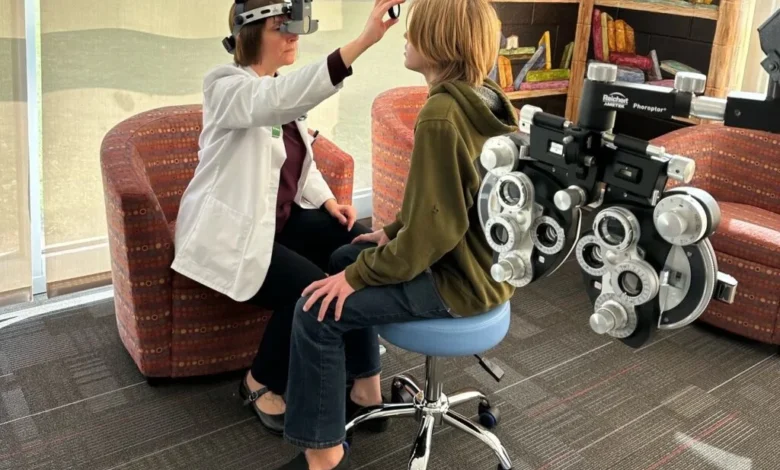New Ohio Program to Boost Children’s Vision Health

A significant new initiative, the Ohio Student Eye Exam (OhioSee) program, is set to transform vision care for young students across Ohio. This $10 million program, part of the state’s two-year operating budget, will provide comprehensive eye exams and glasses directly at schools for students in kindergarten through third grade. The goal is to catch vision problems early, ensuring children have the best possible chance to succeed in their formative years.
Ohio Governor Mike DeWine highlighted the urgency of the program, noting that an estimated 35,000 Ohio students needing glasses did not receive them during the 2022-23 school year. “We will change that, and this budget gets us started down that pathway,” DeWine stated. The program will initially focus on areas with the highest need to maximize its immediate impact. Improving children’s vision is expected to significantly enhance their academic success, benefiting students, families, and schools alike.
The Need for Early Intervention
According to the American Optometric Association, approximately 1 in 4 school-aged children have vision problems that can hinder their ability to learn. Dr. Elizabeth Muckley, executive director and CEO of the Ohio Optometric Association, emphasized the importance of early detection: “Obviously, we want to catch kids early… so that they aren’t going for a long time without the ability to see in their formative years.”
Many students who fail a routine school vision screening often don’t receive the necessary follow-up care due to various barriers, including lack of transportation, a scarcity of providers in certain areas, or being underinsured. For instance, Vinton County in Ohio has no optometrists, meaning residents might have to travel an hour or more to access eye care, as noted by Dr. Shane Foster, an optometrist with practices in Athens, Logan, and Columbus.
The Pioneering iSee Program Paves the Way
The new OhioSee program builds upon the successful foundation laid by the Ohio Optometric Foundation’s iSee program. For the past 15 years, iSee has been providing no-cost comprehensive eye exams for children in schools, primarily reaching students who failed initial screenings or are on individualized education programs (IEPs) and struggling in school.
Dr. Foster, who participates in the iSee program, shared its profound impact: “The greatest thing about working with this program is that it seems like such a simple thing, but it can change a child’s entire life trajectory.” He explained that many students struggling academically might simply need glasses, a relatively inexpensive solution that can prevent vision problems from being misdiagnosed as learning disabilities.
The iSee program also provides free glasses to students who need them, with approximately 85% of examined students receiving them. Since its inception, iSee has administered about 6,000 exams and prescribed almost 2,800 pairs of glasses. In 2024 alone, 721 student exams were conducted, resulting in 603 glasses prescribed through 38 clinics. The iSee clinics visited numerous Ohio counties during the 2024-25 school year, including Butler, Clark, Cuyahoga, Franklin, Hamilton, and many others, demonstrating the critical role such programs play in reaching underserved communities.
Modernizing Optometric Care: Ohio Senate Bill 36
In a related effort to improve vision care access and modernize the profession, Ohio Senators Jerry Cirino and George Lang introduced Senate Bill 36. This bill aims to update the scope of practice for Ohio’s optometrists for the first time in 17 years. If passed, it would broaden the types of drugs optometrists can prescribe and allow them to perform certain in-office, non-invasive laser procedures, such as removing benign lesions like cysts, styes, and skin tags.
It’s important to note that this bill would not permit optometrists to perform more invasive procedures like LASIK or cataract eye surgery. The proposed changes align Ohio with other states; 12 states, including Kentucky and Indiana, already allow optometrists to use lasers, and 22 states permit eyelid lesion procedures similar to those outlined in S.B. 36.
Dr. Muckley explained the importance of this modernization: “We don’t want young optometrists and graduates leaving our state to go to states that have a more modern scope of practice.” This legislation seeks to reduce unnecessary red tape and delays in vision care, ultimately benefiting patients across the state.
The combined efforts of the new OhioSee program and legislative initiatives like Senate Bill 36 signify a strong commitment to improving vision health and educational outcomes for Ohio’s children. These programs are designed to break down barriers to care, ensuring that more students receive the eye exams and glasses they need to thrive in school and beyond.




